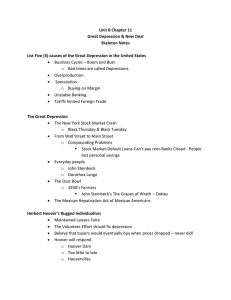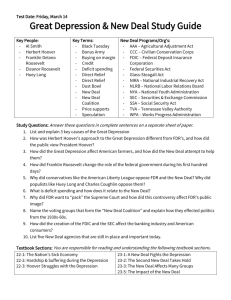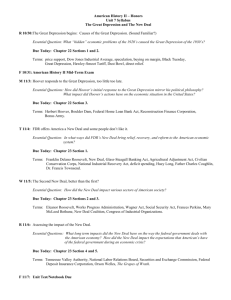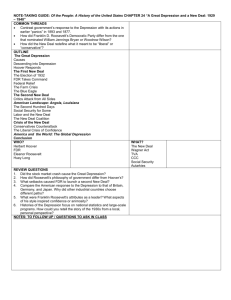Lesson Plans - Kelly Schneider
advertisement
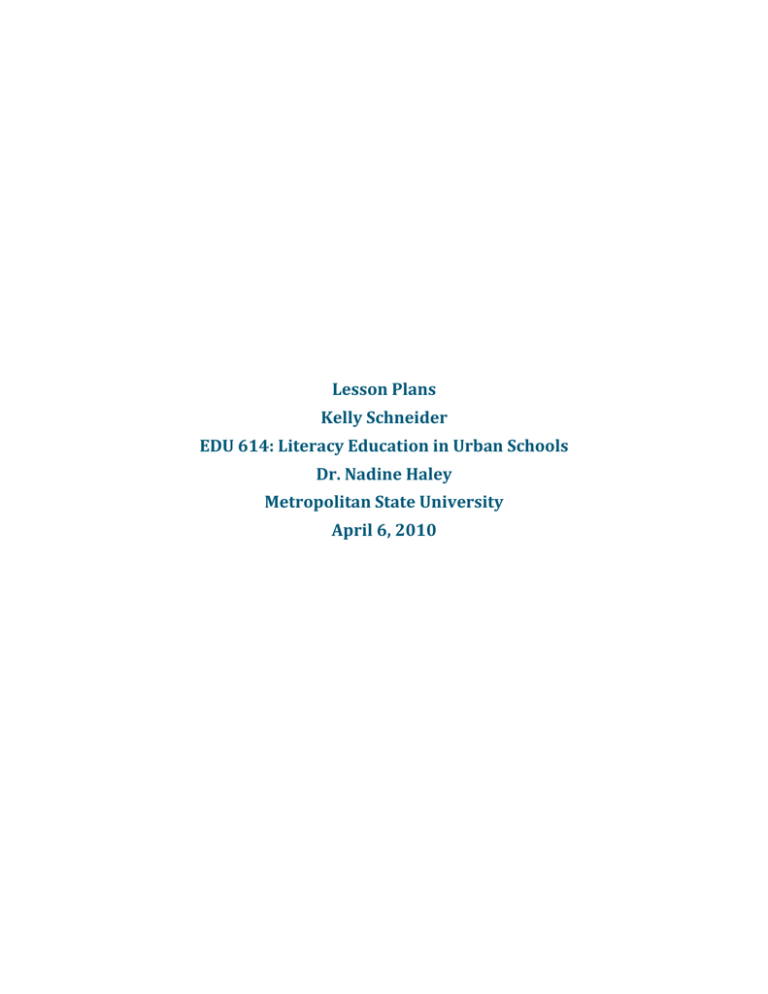
Lesson Plans Kelly Schneider EDU 614: Literacy Education in Urban Schools Dr. Nadine Haley Metropolitan State University April 6, 2010 Unit Title: The Great Depression Lesson Title: (1) Hindsight is 20/20 Grade Level: 7 Date: Objectives Students will be able to: Describe the social changes of the 1920s. Identify the economic changes leading up to the Stock Market Crash of 1929. Provide two examples of economic trends that affected everyday living. Culturally Responsive Teaching Focus Asian immigrants in the early 1920s (see Activities) Materials Timeline: Poster board (1 per group) Markers (1 orange and green for each group) Magazines for cutting (3-4 per group) Glue sticks or tape (1-2 per group) Worksheet: Bookmark Technique (1 per student) Opening Activity Ask: What is a fad? Teacher will provide an example with image. Ask: What are some examples of fads? Assessment 1 Start Great Depression KWLS (K and W) (see strategy log). Procedures 1. Opening Activity 2. Assessment 1 3. Timeline. a. Class will review definitions of culture, economic, and social. b. Teacher will explain what a timeline is and provide an example. c. Teacher will write textbook passages on board (sections on social change, economic change, and legislation of the 1920s). d. Assign students to groups of 3-4 and provide each group with timeline supplies. e. Each group will create a timeline for 1920-1929 (up to but not including the Stock Market Crash in October), using the textbook as a reference. f. Each group will include at least 3 social or cultural events (written in orange), and 3 economic events (written in green). g. Timeline will include pictures to illustrate the events. h. Give groups 15 minutes to complete the timelines. i. Have groups display their timelines in the room. A spokesperson from each group will share 1 event and explain why it was included. j. On board, record events mentioned, keeping social or cultural and economic events separate. k. Ask: What other events did your timelines include? i. Add these to the list on the board. ii. Point out any that were not included, if necessary. 4. Immigration Act of 1924 activity (see Activities). 5. Assessment 2 6. Assign homework (see Homework). Activities: Immigration Act of 1924 Say: One of timeline events was the Immigration Act of 1924. Congress reduced the number of immigrants allowed into the United States each year to 2% of each nationality group counted in the 1890 census and barred Asians entirely. Ask: What do you think it felt like to be an Asian immigrant in the early 1920s? Were Americans friendly toward immigrants? In pairs, students will read text on the Immigration Act of 1924. They will discuss which social or cultural events, trends, or fads (using list on the board) immigrants may have experienced, and which they may have been excluded from. Give pairs 5 minutes to discuss. Have class stand up. Students will move to the right side of the room if they think the event was something immigrants participated in, and to the left side if they think immigrants were excluded. Go through list on board, asking for one student from each side to explain why. Assessment 2 Students write down 2 economic trends (from the list on the board or the timelines) and give a one sentence explanation of how each changed everyday living. Turn in. Homework Textbook reading: Introduce BOOKMARK TECHNIQUE (see strategy log) and provide students with handout of the bookmarks. Reflection Were students able to identify social, cultural, and economic changes? Did students connect societal changes to everyday life? Was there any background information they didn’t have but needed? Next class: Black Tuesday Unit Title: The Great Depression Lesson Title: (2) Black Tuesday Grade Level: 7 Date: Objectives Students will be able to: Identify the cause and effect relationship between Black Tuesday and the Great Depression. Define the vocabulary terms: 1929 stock market crash, recession, depression. Explain how events of the 1920s led to the stock market crash. Culturally Responsive Teaching Focus Harlem Renaissance (see Opening Activity) Materials Pictures Post-Its (1 per student per photograph in slide show) Markers (1 per student) Worksheet: Black Tuesday outline (1 per student) Worksheet: Gallery Images (1 per student) Opening Activity Introduce students to Harlem Speaks: A Living History of the Harlem Renaissance by Wintz and Western Echoes of the Harlem Renaissance: The Life and Writings of Anita Scott Coleman by Davis. Share brief excerpt from each (audio from Harlem Speaks, reading from Western Echoes). Make available in classroom library. Assessment 1 SEMANTIC M AP (see strategy log): Brainstorm possible causes of the Great Depression. Procedures 1. Opening Activity 2. Assessment 1 3. Pictures a. Slideshow of pictures (Dorothea Lange). One student from each row/section should get pictures supplies. Students will write a 1 word response to each picture. Teacher will provide an example for the first picture. Students will post their words on the wall. b. Ask: What words appear many times? Based on these pictures and words, what do you think life was like during the Great Depression? 4. In pairs, students will read a short overview of the Great Depression (textbook), using PAIRED QUESTIONING (see strategy log). Pairs will define recession and depression, using the textbook and/or dictionaries; definitions need to be rewritten in their own words. Each pair will write down definitions and hand them in (Assessment 2). 5. Brief (5 minutes) overview of Black Tuesday (give students worksheet to fill out). 6. Display: Why was Black Tuesday significant? Do you think the Great Depression would have happened if the stock market didn’t crash (think about the changes noted in lesson 1)? Who was affected most by the events of Black Tuesday? Partners discuss. a. Ask students to share what they discussed in pairs. 7. Gallery Images (see Activities) 8. Assessment 2 9. Assign homework. Activities Introduce G ALLERY IMAGES (see strategy log); teacher will provide an example. Students will practice by filling out the Gallery Images worksheet for the readings and discussions of Black Tuesday. Encourage students to draw at least 2 pictures and write a 1 sentence description of each picture. Have students turn these in (Assessment 2). Assessment 2 Pairs turn in definitions (Procedures #4). Individuals turn in sample Gallery Images (Activities). Homework Textbook reading on 1929-1933 (Hoover). Students will use GALLERY I MAGES (see strategy log) to aid comprehension. Reflection Did students make the Black Tuesday – Great Depression connection? Which pictures did students respond well to? Poorly? Next class: Hoover Unit Title: The Great Depression Lesson Title: (3) Hoover Grade Level: 7 Date: Objectives Students will be able to: Analyze the impact of the Great Depression. Define vocabulary terms: unemployment, bread lines, Dust Bowl, Hooverville. Identify the positive and negative effects of actions taken by the Hoover administration. Culturally Responsive Teaching Focus Spanish Harlem Materials Group Activity: Poster with two columns: Helpful, Harmful Note cards Tape Markers Worksheet: Worldwide Effects of the Great Depression (1 per pair) Opening Activity Read excerpt from Women of the Depression by Blackwelder (personal letters, interviews, and diaries of early Spanish Harlem). Assessment 1 QUICK WRITE (see strategy log): What actions could the government take to fight the Great Depression? Share in small groups. Procedures 1. Opening Activity / Culturally Responsive Teaching Focus 2. Assessment 1 3. Group Activity: a. Explain: We’re going to examine the actions the government took to fight the Great Depression. b. Assign small groups (no more than 4). Assign each group a policy, program, or action of the Hoover administration, and provide each group with a note card and marker. c. Groups will use the DISCUSSION WEB (see strategy log) format to evaluate if the actions were helpful or harmful. After making a conclusion, each group will write their topic on a note card and place it on the poster. d. While groups discuss, teacher will place Helpful/Harmful poster on wall or and place tape nearby. 4. Explain the vocabulary words (unemployment, bread lines, Dust Bowl, Hooverville). 5. Assign homework. 6. Library research (see Activities) 7. Assessment 2 Activities Library research: Students pair up while teacher hands out worksheets. Each pair will select a region to research (NE, SE, MW, NW, SW). Pairs will have the rest of the period to fill out the worksheet for their region. Assessment 2 Pairs turn in worksheets before leaving class. Homework Students will create a slogan for a poster for the presidential campaign against Hoover (one lettersized sheet of paper, black and white or color). Teacher will provide a real example from Roosevelt’s campaign. Reflection Did the Discussion Web activity work? Was the library research productive? How did students respond to Women of the Depression? Next class: Roosevelt Unit Title: The Great Depression Lesson Title: (4) Roosevelt Grade Level: 7 Date: Objectives Students will be able to: Explain FDR’s role in the Great Depression. List several factors that led to banking reform. Culturally Responsive Teaching Focus Segregation in the Civilian Conservation Corps (see Procedures #5) Materials Handout: Full text of FDR’s First Fireside Chat with selected section clearly marked (1 per student) 3 letters to Roosevelt Worksheet: Narrative Pyramid (1 per student) Handout: Printout of http://www.u-s-history.com/pages/h1586.html (Civilian Conservation Corps, 1933-1041) through “Segregation and education” section (1 per student) Handout: Extra credit assignment Opening Activity Display and share homework (election posters). Teacher will share several examples from Roosevelt’s campaign. Assessment 1 Review: How did we get here? On a sheet of paper, students will list events from 1929-1933. They will mark events C for cause or E for effect where possible. Procedures 1. Opening Activity 2. Assessment 1 3. Fireside Chats a. Hand out full text of FDR’s First Fireside Chat. Listen to short section of the audio recording (13:42 total) or video. Students will follow along on handout, circling important ideas and underlining words that need to be defined. b. Ask: What were the key elements of the bank holiday? Give specific examples of how FDR explains the banking system. Do you think this speech was effective? Why or why not? c. Ask for volunteers to read 3 letters that Roosevelt received in response to the Fireside Chats. d. Ask: How did the public respond to the Fireside Chats? 4. Narrative Pyramid (see Activities) 5. CCC Segregation reading a. Provide students with CCC handout. b. Students will have 5 minutes to read/skim the text. c. While students are reading, teacher will write these questions on the board: At its peak, how many men were enrolled in the CCC? At its peak, how many African American men were enrolled? The CCC director said, “Segregation is not discrimination” – do you think this is true? How could we find out? d. In pairs, students will discuss the questions on the board. e. As a class, discuss the CCC director’s statement. f. Ask: How do you think FDR felt about segregation? Where could we go to find this information? 6. Assessment 2 7. Assign homework Activities In pairs, students will complete a NARRATIVE PYRAMID (see strategy log) for Roosevelt using textbook. As a class, discuss what students included on their pyramids. Assessment 2 Students write letters to FDR as a 1933 person, responding to his Fireside Chats. Students will start their letters in class and finish for homework. Homework Textbook reading on New Deal, using SAVE THE LAST WORD FOR ME (see strategy log). Finish letter to FDR. Extra credit: Listen to the President’s weekly radio address (current); write 1 paragraph in response, comparing and contrasting to FDR’s Fireside Chats (handout). Reflection Does more time need to be spent on banking reform? Was the Fireside Chat audio/video effective? Did students have enough time for the Narrative Pyramid activity? Next class: The New Deal Unit Title: The Great Depression Lesson Title: (5) The New Deal Grade Level: 7 Date: Objectives Students will be able to: Outline key programs of the New Deal. Identify positive and negative aspects of the New Deal. Analyze the impact of New Deal programs on specific populations. Culturally Responsive Teaching Focus Native Americans and the New Deal (Indian Reorganization Act of 1934) (see Activities). Materials Worksheet: Concept of Definition Map (1 per student) Handout: Journal prompt for homework (1 per student) Opening Activity FDR’s Legacy Collect letters to FDR. Ask: What is a legacy? What do you want your legacy to be? Say: FDR’s legacy was the New Deal, which we’re looking at today. Assessment 1 In small groups, share homework (SAVE THE LAST WORD FOR ME). Procedures 1. Opening Activity 2. Assessment 1 3. Using the textbook, class will brainstorm a list of New Deal programs; teacher will record on board. 4. Ask: Which of these programs do you think were most important? Have class vote to narrow the list down to 4-5 key programs (exclude the IRA). 5. Break students into 4-5 groups; assign each a program. Groups will analyze the programs, focusing on who the program affected (or missed) and how. a. Have each group report on their findings. b. Ask: What groups, if any, did not have any programs designed for them? 6. IRA activity (see Activities) 7. Assessment 2 8. Assign homework Activities Say: Let’s see what the textbook has to say about the Indian Reorganization Act. What was it supposed to do? Were the results positive or negative, according to the textbook? Thinking outside the textbook, how were Native Americans’ lives affected by the IRA? Did they feel it was positive or negative? Display these questions on board. Have small groups discuss. Assessment 2 CONCEPT OF DEFINITION MAP for New Deal (see strategy log): Hand out worksheet and have students complete individually. Turn in (homework). Homework Journal: Did the New Deal programs reach everyone? If yes, in your opinion, which program(s) were most effective? If no, who was not affected by New Deal programs? Why do you think people were left out? What kinds of programs could have helped them? Reflection What was the response to the IRA activity? Was “legacy” a good opener? Which New Deal programs did students respond best to? Next class: N/A

